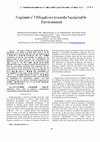Papers by Mosharrof Hussain Masud

International Publisher for Advanced Scientific Journals (IPASJ), Jul 1, 2018
Bandwidth aggregation in heterogeneous wireless networks (HWN) can be one of the effective soluti... more Bandwidth aggregation in heterogeneous wireless networks (HWN) can be one of the effective solutions in providing quality data transmission for real-time applications. However, transmitting the data through multiple networks create packet reordering issues that result in transmission delay and degrades the overall quality of services. This paper addresses packet reordering issues both for single and multiple paths with a reordering delay in the transmission system. An algorithm has proposed to mitigate the associated delay that has been simulated in network simulator 3 (NS3). The simulation results have benchmarked with the well known Earliest Delivery Path First (EDPF) method and shown better performance over the EDPF results. Moreover, the simulation has been done to analyze the packet scheduling including to measuring packet reordering delay, and reordering entropy. CBR and VBR applications have been transmitted for 1800ms from sender to receiver in a heterogeneous wireless environment created in NS3. The results show the proposed method achieved to reduce the reordering delay and reordering entropy both for CBR and VBR applications

Indonesian Journal of Electrical Engineering and Computer Science, 2018
In next-generation wireless networks, a Multi-Mode Device (MMD) can be connected with available R... more In next-generation wireless networks, a Multi-Mode Device (MMD) can be connected with available Radio Access Technology (RAT) in a Heterogeneous Wireless Network (HWN). The appropriate RAT selection is essential to achieve expected Quality of Service (QoS) in HWN. There are many factors to select an appropriate RAT in HWN including Data rate, Power consumption, Security, Network delay, Service price, etc. Nowadays, the MMDs are capable to handle with multiple types of services like voice, file downloading, video streaming. Considering numerous factors and multiple types of services, it is a great challenge for MMDs to select the appropriate RAT. A Multi-Attribute Decision Making (MADM) method to deal with numerous attributes to achieve the expected goal is Technique for Order Preference by Similarity to Ideal Solution (TOPSIS). This research utilized TOPSIS method to evaluate its proposed algorithm to choose the proper RAT for single and dual call services. The algorithm applies use...
Indonesian Journal of Electrical Engineering and Computer Science, 2018
In next-generation wireless networks, a user can be connected through Multi-Mode Device (MMD) to ... more In next-generation wireless networks, a user can be connected through Multi-Mode Device (MMD) to the multiple wireless networks in Heterogeneous Wireless Networks (HWN) considering several factors; including network technology, data service type, available bandwidth, Quality of Service (QoS), monetary cost, etc. To deal with all these multi attributes, game theory based models have been used to point out a better solution. This paper evaluates the techniques, methods, advantages, limitations of some game theory-based models for wireless resource allocation in HWN. Finally, it concludes that the Shapley Value method can be used for further research activities for its efficiency.

2013 1st International Conference on Artificial Intelligence, Modelling and Simulation, 2013
Interactive Multimedia (IMM) applications have observed quick growth in the world of computer and... more Interactive Multimedia (IMM) applications have observed quick growth in the world of computer and communication technologies. Voice, video conferencing, graphics services are considered as IMM applications, at low cost with more flexibility in a high speed Wireless Local Area Network (WLAN) that can be defined as a high speed Wireless Campus Network (WCN). The networks' traffic flow determines the participating users work as a sender or receiver during the voice or video conversation. The IMM applications have to be kept the least data loss and maximum throughput over WCN. Packets scheduling and channel allocation mechanism are the challenging issues for improving IMM transmission and it is still an unresolved problem over WCN. This paper reviews on different exist scheduling mechanisms and channel allocation algorithms of IMM related to various applications and highlights the current issues. A new priority based scheduling scheme and dynamic channel allocation mechanisms have been proposed in this paper. It is expected that the proposed mechanisms ensure the minimum requirement of the IMM applications which will deliver QoS with the least handoff delay and minimize the call dropping probabilities for IMM applications though WCNs.
2014 IEEE Symposium on Computer Applications and Industrial Electronics (ISCAIE), 2014
Interactive Multimedia (IMM) applications such as voice and video conferencing are very important... more Interactive Multimedia (IMM) applications such as voice and video conferencing are very important in our learning environment. They offer useful services that benefit its users but these services suffers performance degradation from today's high speed Wireless Local Area Network (WLAN). However, guaranteed Quality of Service (QoS) remains the bottleneck in the network which becomes a great challenge in attempting to improve its performance. This work

Heterogeneous Wireless Network (HWN) is the next generation wireless communication system's platf... more Heterogeneous Wireless Network (HWN) is the next generation wireless communication system's platform where Internet services will be offered and delivered through multiple technologies like WiFi, WiMAX, GSM etc. There are some Internet applications that require high bandwidth and therefore, the bandwidth of an individual interface need to be aggregated to form a high speedy logical link. In this regard, some critical issues like packet loss, packet reordering and delay need to be addressed efficiently. This paper aims to investigate the common scheduling algorithms both adaptive and non-adaptive solutions that have been using in networking and communication field. Packet reordering is common in heterogeneous wireless network that has been evaluated briefly in reorder metrics analysis and reorder delay analysis sections. The challenges of packet reordering are also addressed in this paper. This paper gives a state-of-the-art knowledge of bandwidth aggregation and packet reordering in HWN and it is expected that this investigation will be a milestone for further research.
2012 International Conference on Computer and Communication Engineering (ICCCE), 2012
Abstract The number of wireless applications, services and devices such as mobile telephone hands... more Abstract The number of wireless applications, services and devices such as mobile telephone handsets, laptops and personal digital assistant (PDAs) are growing rapidly. The next generation wireless technology systems are being devised with the vision of heterogeneity where a mobile user will be connected with multiple wireless networks like GPRS/UMTS, IEEE 802.1 x, WiMAX and satellite etc. To connect the above devices, a primary interface can be assigned to a mobile node (MN). Mobile users should be ...

2012 International Conference on Computer and Communication Engineering (ICCCE), 2012
Wireless Mesh Network (WMN) have been envisioned as an important solution to the next generation ... more Wireless Mesh Network (WMN) have been envisioned as an important solution to the next generation wireless networking which can be used in wireless community networks, wireless enterprise networks, transportation systems, home networking and last-mile wireless internet access. Many proprietary mesh solutions were developed by individual vendor but in order to interoperability; IEEE forms a task group called IEEE 802.11s to develop an integrated mesh networking solution. Hybrid Wireless Mesh protocol (HWMP) and airtime metrics as default routing protocol and routing metrics set by the task group. There is few test bed and many simulation studies have been done to evaluate the performance of the HWMP protocol with the assumption of unique type of flow with fixed packet size and packet rate. However, real networks carry a diverse application (video, voice, FTP, Email etc) with different characteristics (packet size, data rate). In this paper, we are investigated and analyzed the performance of HWMP protocol under such heterogeneous application characteristics.
2012 International Conference on Computer and Communication Engineering (ICCCE), 2012
Abstract MIPv6 is envisioned for next generation networks to achieve ubiquitous and seamless comm... more Abstract MIPv6 is envisioned for next generation networks to achieve ubiquitous and seamless communications for its wide address spaces and many additional features. However, MIPv6 is not widely deployed due to handoff latency and other limitations leading to packet loss and Quality of Service (QoS) degradation for real time applications such as audio and video streaming. MIPv6 handoff latency can be categorized into layer 2 (L2) and layer 3 (L3) delays that includes link layer establishment delay, movement detection delay ...

Information and Communication Technology (ICT) plays a key role in the development and the sustai... more Information and Communication Technology (ICT) plays a key role in the development and the sustainability of the modern life. It brings numerous benefits and facilities to the society and users. However, the usage of the ICT devices and its entire life cycle produce hazardous substances including harmful CO2. Reducing the energy consumption in an individual or organizational level effected the ultimate reduction of CO2 in global perspective. Therefore, the adoption of green ICT is becoming more popular due to the increasing number of ICT infrastructures and facilities. Considering this issue in mind, this paper addresses the scenario of energy consumption in the field of ICT in a global context. Particularly, an awareness survey has been conducted among staff and students of International Islamic University Malaysia (IIUM) to assess the adoption trend of green ICT in campus. Public awareness is considered one of the most important factors to increase the adoption of green ICT in everywhere. During the group survey, a short briefing and discussion also have been conducted to inform and motivate the students about green ICT. The survey results show that some interviewees are still not familiar with this "green ICT" term and its adoption. Therefore, further motivation and influence need to be drawn among staff and students towards a sustainable environment.

Next Generation Networks (NGN) both static and mobile are expected to be fully Internet Protocol ... more Next Generation Networks (NGN) both static and mobile are expected to be fully Internet Protocol Version 6 (IPv6) based. Mobility in IPv6 (MIPv6) network was designed to provide Internet services to end users at anytime and anywhere. However, MIPv6 is not widely deployed yet due to handoff latency and other limitations leading to packet loss and Quality of Service (QoS) degradation for real time applications such as audio and video streaming. MIPv6 handoff latency can be categorized into layer 2 (L2) and layer 3 (L3) delays that includes link layer establishment delay, movement detection delay, address configuration delay and binding update or registration delay. Movement detection delay and address configuration including Duplicate Address Detection (DAD) in L2 and L3 respectively consume the highest time of the total delay. In order to reduce these handoff latencies, two solutions are proposed to focus all the delays both in L2 and L3. The first solution is the fuzzy logic technique based network awareness to reduce movement detection delay especially the scanning time in L2 in heterogeneous networks. The second solution is Parallel DAD (PDAD) to reduce address configuration time in L3. Both solutions benchmarked with OMNeT++ simulator show improvements over standard MIPv6 networks. The handoff latency reduced more than 50% and packet loss improved around 55% in L2. Moreover, in L3 the handoff latency reduction accounts for 70% and packet loss improved approximately 60%. The handoff latency is reduced from 1300 ms to 500 ms applying fuzzy logic technique at L2 and PDAD mechanism in L3 leading to overall delay reduction of 60%.
2013 INTERNATIONAL CONFERENCE ON COMPUTING, ELECTRICAL AND ELECTRONIC ENGINEERING (ICCEEE), 2013
2011 4th International Conference on Mechatronics (ICOM), 2011
Abstract Next Generation Networks (NGN) are envisioned to be fully Internet Protocol (IP) based s... more Abstract Next Generation Networks (NGN) are envisioned to be fully Internet Protocol (IP) based so that users can experience high quality and ubiquitous communication. In order to realize this, Internet Engineering Task Force (IETF) is taking advantage of Mobile Internet Protocol version 6 (MIPv6) because it has more suitable features than MIPv4. However, MIPv6 is not widely deployed due to handoff latency and other limitations. This causes packet loss and degrades the Quality of Service (QoS) for real-time applications. MIPv6 ...
2011 4th International Conference on Mechatronics (ICOM), 2011
Abstract Efficient multicasting over Wireless Mesh Network (WMN) is challenging due to dynamic an... more Abstract Efficient multicasting over Wireless Mesh Network (WMN) is challenging due to dynamic and multi-hop wireless communication among multicast group members. Multicast Ad hoc On-Demand Distance Vector (MAODV) protocol is a tree based multicast routing protocol that enables dynamic, self-starting, multi-hop routing between participating mobile nodes wishing to join or participate in a multicast group in Wireless Mesh Network (WMN). The mobility of mobile nodes often causes link breakage in the tree-based protocols which ...
2014 International Conference on Informatics, Electronics & Vision (ICIEV), 2014

International Journal of Networks and Communications, 2012
Customarily, the design of an efficient routing protocol for Wireless Mesh Networks (WMNs) demand... more Customarily, the design of an efficient routing protocol for Wireless Mesh Networks (WMNs) demands sufficient consideration of the pertinent features. This is due to the fact that WMNs can be permanent or semi-permanent networks. Moreover, a reliable path from the source to the destination can be maintained using an improved and better performance metrics. Currently, the most widely used performance metric is the minimum hop-count which is based on the assumption that communication links are either working well or not working at all. This assumption is true for wired networks however this is impractical for wireless networks where numerous links suffer from intermediate loss ratios, low throughput, interference and other inherent limitations. Consequently, researchers have proposed a number of performance metrics for WMNs. It has also been shown that integrating multiple performance metrics into a routing protocol is effective for attaining optimal performance since it is highly probable that a single performance metric will not be able to satisfy the comprehensive requirements of WMNs. This paper presents a technique of integrating multiple routing metrics in order to optimize the performance of a routing protocol. The proposed technique is implemented on Multicast Ad-hoc On-Demand Distance Vector (MAODV) routing protocol. Simulation results show a statistically significant performance improvement over standard MAODV for WMNs.

IOP Conference Series: Materials Science and Engineering, 2013
ABSTRACT Mobile IPv6 (MIPv6) is one of the pioneer standards that support mobility in IPv6 enviro... more ABSTRACT Mobile IPv6 (MIPv6) is one of the pioneer standards that support mobility in IPv6 environment. It has been designed to support different types of technologies for providing seamless communications in next generation network. However, MIPv6 and subsequent standards have some limitations due to its handoff latency. In this paper, a fuzzy logic based mechanism is proposed to reduce the handoff latency of MIPv6 for Layer 2 (L2) by scanning the Access Points (APs) while the Mobile Node (MN) is moving among different APs. Handoff latency occurs when the MN switches from one AP to another in L2. Heterogeneous network is considered in this research in order to reduce the delays in L2. Received Signal Strength Indicator (RSSI) and velocity of the MN are considered as the input of fuzzy logic technique. This technique helps the MN to measure optimum signal quality from APs for the speedy mobile node based on fuzzy logic input rules and makes a list of interfaces. A suitable interface from the list of available interfaces can be selected like WiFi, WiMAX or GSM. Simulation results show 55% handoff latency reduction and 50% packet loss improvement in L2 compared to standard to MIPv6.

IOP Conference Series: Materials Science and Engineering, 2013
ABSTRACT International Islamic University Malaysia (IIUM) is one of the leading universities in t... more ABSTRACT International Islamic University Malaysia (IIUM) is one of the leading universities in the world in terms of quality of education that has been achieved due to providing numerous facilities including wireless services to every enrolled student. The quality of this wireless service is controlled and monitored by Information Technology Division (ITD), an ISO standardized organization under the university. This paper aims to investigate the constraints of wireless campus network of IIUM. It evaluates the performance of the IIUM wireless campus network in terms of delay, throughput and jitter. QualNet 5.2 simulator tool has employed to measure these performances of IIUM wireless campus network. The observation from the simulation result could be one of the influencing factors in improving wireless services for ITD and further improvement.

The earth is being over populated day by day. Accordingly, it is failing to provide basic needs t... more The earth is being over populated day by day. Accordingly, it is failing to provide basic needs to all the populations of the current world since it has the limited natural consideration to run the earth smoothly. As engineers are the important body of the society, they have responsibilities and obligations to the society especially to the environment. In this mentioned with respect to society, economy and environment. To make the environment sustainable, basic components like air, water, land etc. of the environment need to be kept safe and secured that can be done by the proper engineering planning. In esponsibilities are also highlighted in this paper. Energy shortage is one of the Climate change is another phenomenon of the current world that the inhabitants are experiencing regularly. The most environmental facts are related to construction engineering. So, are explicated in this paper.
Journal of Applied Sciences Research, 2012
Information and Communication Technology (ICT) is one of the fast growing industries that facilit... more Information and Communication Technology (ICT) is one of the fast growing industries that facilitate many latest services to the users and therefore, the number of users is increasing rapidly. The increment of the number of users is proportional to the ICT infrastructures. ICT infrastructures produce numerous environmental pollutions during its production and disposal. The usage and its life cycle produce hazardous substances that need to be addressed in efficient and green ways. In this regards, this paper evaluates the ...











Uploads
Papers by Mosharrof Hussain Masud